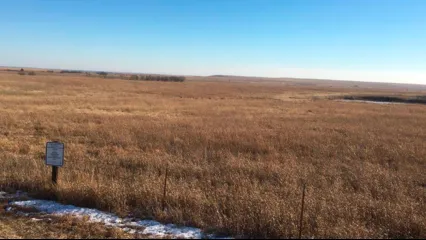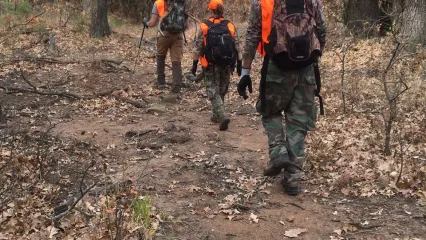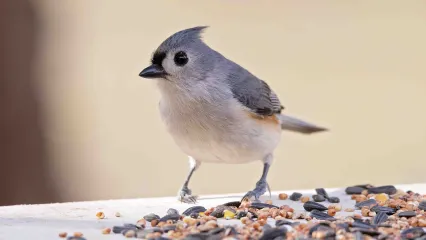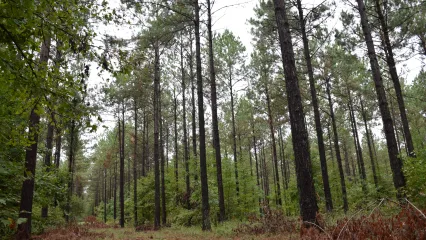Attention Non-Residents
The Oklahoma Wildlife Conservation Commission adopted new rules in 2025 that require non-residents accessing certain Oklahoma public hunting and fishing areas to check in and out of the area. By checking in and out of these areas, hunters, anglers, shooters, birdwatchers, hikers and any other users can help the Wildlife Department better understand how the area is being used. There is no additional cost associated with checking in or out of an area. There is no limit to the number of check ins for an individual in a year.

John Dahl WMA covers 480 acres in western Osage County in north central Oklahoma. Located 1 mile east of Foraker, Oklahoma, John Dahl is a mixture of tallgrass prairie and cropland. A small creek bordered by timber transects the area from north to south.
From Foraker: 1 mile east on CR4650, ½ mi south on CR4545.
- Quail: Bobwhite quail are present in good numbers during most years.
- Deer: White-tailed deer are present in fair numbers.
- Rabbit: Cottontails are usually present in good numbers.
- Furbearers: Coyote, bobcat and raccoon are present.
- Dove: Good dove hunting is usually available over native sunflowers and weeds. A 20 acre wheat field is also planted and manipulated annually to provide increased opportunity.
- Waterfowl: Ducks commonly use the ponds and creeks and potholes on the areas. Waterfowl hunting usually improves when heavy rainfall occurs.
- Greater Prairie Chicken: Although the season is closed for these birds, the greater prairie chicken can be easily viewed utilizing grain field during late fall and winter.
- Bald Eagle: The bald eagle is a common visitor to the area during winter months.
- Upland Sandpiper: Sandpipers are common between March and August.
Approximately 60 acres of wheat, soybeans and corn are planted annually. An additional 25 acres of disk plots are worked each winter to promote the germination and growth of native sunflowers and other wildlife favorable forbs. These management practices are performed in areas that were comprised of the highest densities of the non-native invasive plant species Sericea Lespedeza.
Fire is used to maintain the open grassland habitat that dominates John Dahl WMA. Through patchwork prescribed burns conducted throughout the year, undesirable invasive plant species are controlled and desired plant species are benefited. Each year, roughly one third of the acreage is burned providing varying plant community responses. These differing plant communities provide different benefits to upland wildlife. Typical plant responses include increased forb production, providing food for wildlife and decreased woody vegetation heights and densities preserving historical tallgrass prairie plant type composition.
Two primitive camping sites are on the WMA.
The small creek and ponds on the area provide limited fishing opportunities.
Closed Seasons
Same As Statewide Seasons
Seasons w/ Special Restrictions
- Deer Gun
Open during the first nine days only.
- Quail, Crow, Snipe, Woodcock, Rabbit, Squirrel, Pursuit with Hounds for Furbearers, Predator/Furbearer Calling, Trapping
Closed during the first nine days of deer gun season.
Hunter and angler camping is allowed in designated areas only during hunting seasons.
GreenCountryOK
1-800-922-2118
Oklahoma Tourism and Recreation Department
Post Office Box 52002
Oklahoma City, OK 73152-2002
(800) 652-6552 or (405) 521-2409
www.travelok.com
Bartlesville Area Convention and Visitors Bureau
201 SW Keeler
PO Box 2366, Bartlesville OK 74005
918-336-8708
1-877-273-2004
Claremore Convention and Visitors Bureau
419 West Will Rogers, Claremore
918-341-2818
www.claremore.org
Sand Springs Chamber of Commerce
918-245-3221
www.sandspringschamber.com
Tulsa Convention and Visitors Bureau
Williams Center Tower II
Two West Second Street, Tulsa OK 74103
918-585-1201
1-800-558-3311
www.visittulsa.com
Q: Are there ducks on John Dahl?
A: Only when the small creek is holding water. John Dahl should not be considered a duck hunter destination.
Q: Is there a lot of hunting pressure on John Dahl?
A: Yes. John Dahl is approximately 480 acres in size. For its size, it receives heavy hunting pressure for dove, quail, and deer with the occasional rabbit hunter.
Q: Can I drive in on John Dahl?
A: No. John Dahl is a walk-in area only. Due to its size, access by motor vehicle is prohibited. Non-ambulatory areas are available on other nearby WMAS including Kaw WMA and Osage WMA.
Apprentice Designation: A Learner's Permit for Hunting
Hunter education has greatly reduced hunting accidents, but if you can’t complete a course right away, the apprentice designation allows you to hunt under supervision. It works like a learner’s permit, giving you the chance to gain real experience safely until you finish hunter education.
Exploring the New Herron Family WMA
The new Herron Family WMA is more than 17,000 acres of hunting land, it is also adventure, access, conservation, and tradition. Thanks to a unique partnership, Oklahoma residents now have a new place to chase deer, call turkeys, hear quail, and pass on the outdoors to the next generation.


